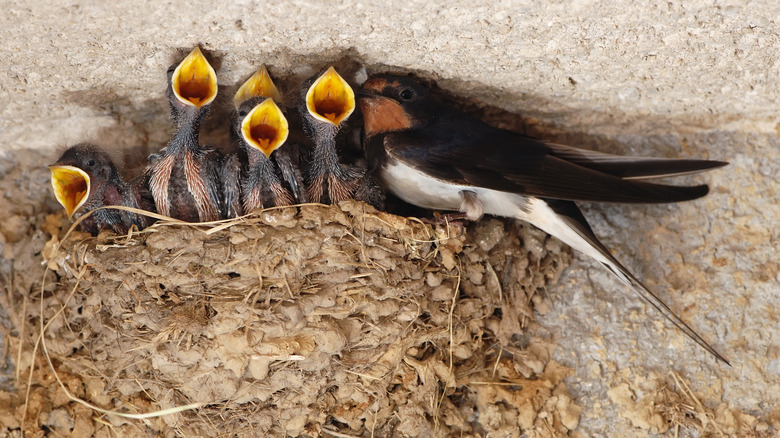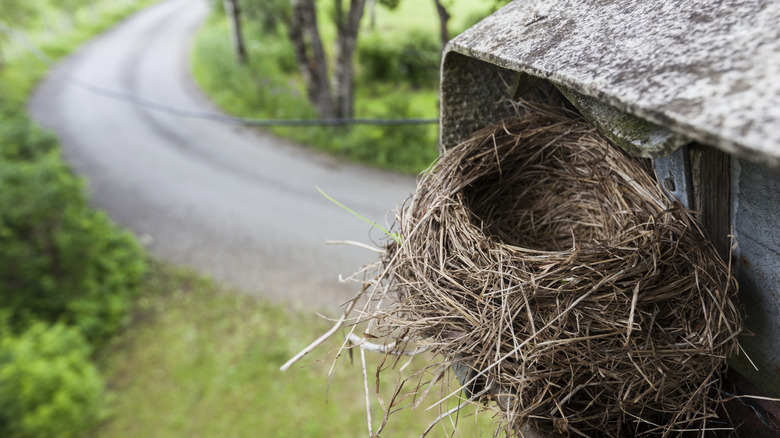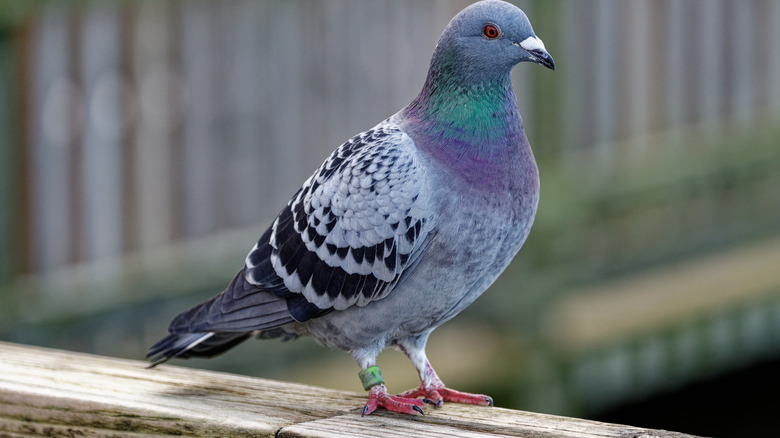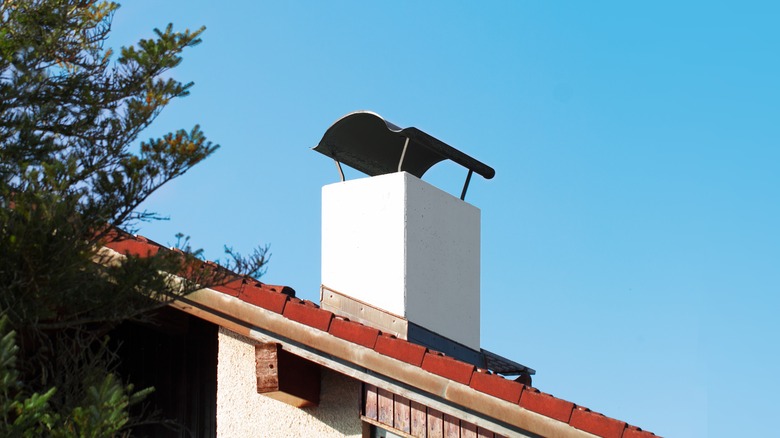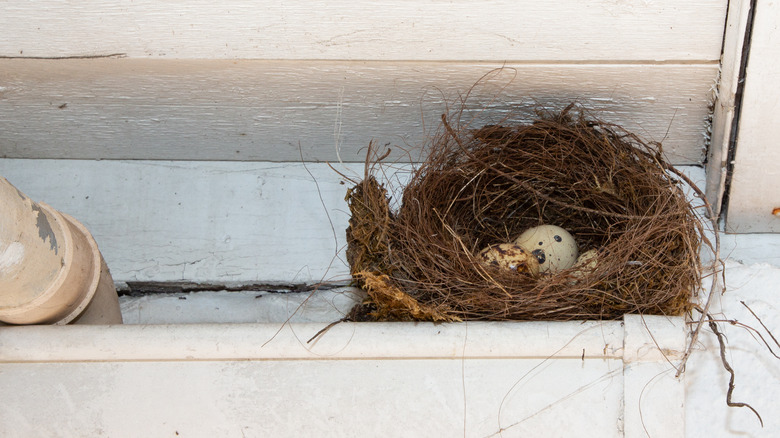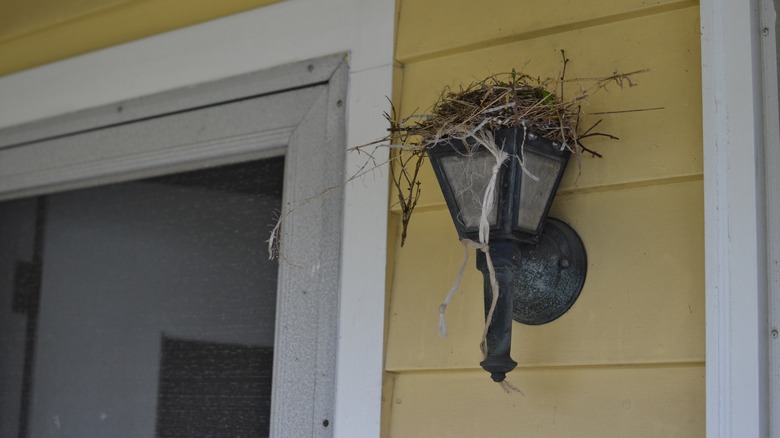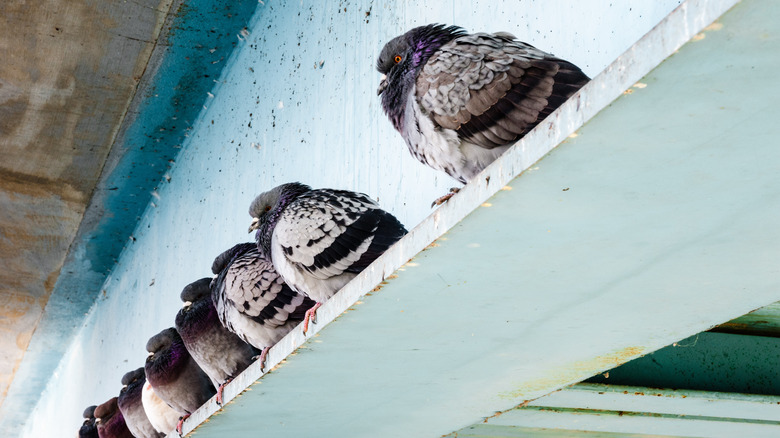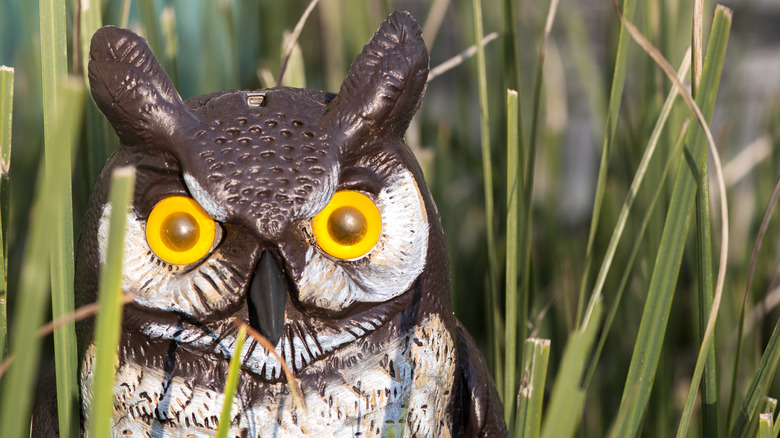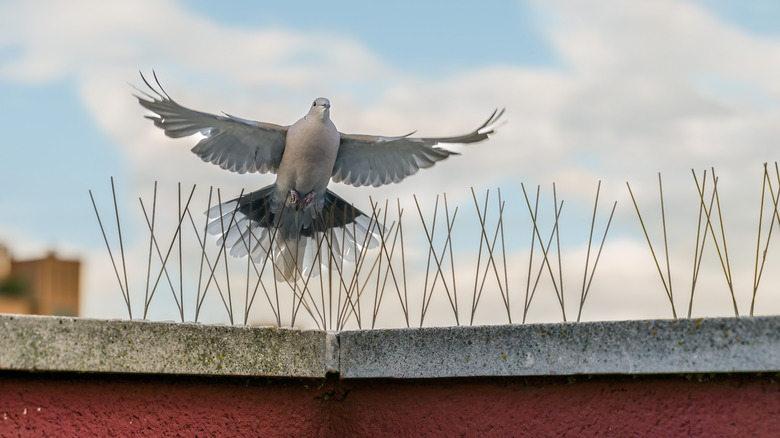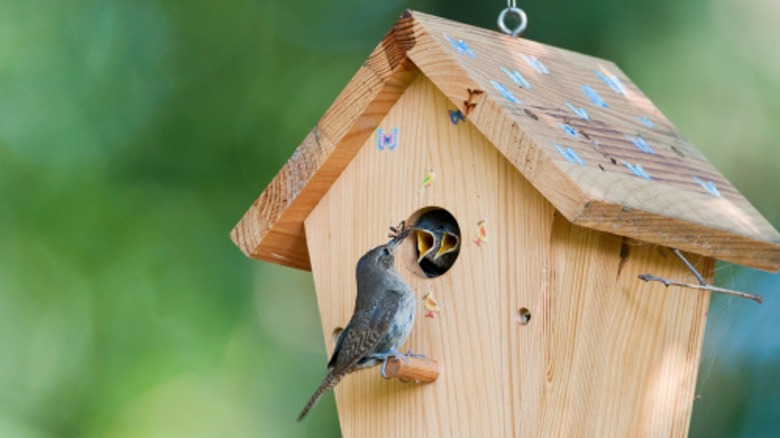9 Clever Ways To Prevent Birds From Nesting Around Your House
Birds can be fun to watch in your backyard, but when they nest on or around your house, they can quickly get too close for comfort. Some birds are fairly aggressive and will protect their nests by swooping toward you and unsuspecting houseguests who get too close to the nesting site. Even more docile species will drop feathers and feces on the ground beneath the nest, creating an unsightly and unsanitary mess quite close to your home.
The best strategy for humanely solving the problem is prevention. But if you've never had problems with nesting birds before, you may not know that you have a problem to prevent. If birds nest on your home before you can exclude them, take heart in the fact that many nesting species only use the nest for about four weeks. After that you can take steps to prevent the problem from reoccurring in the future.
Remove old nests
Removing old nests is an important step for preventing future nesting birds. Bird nests often contain overwintering parasites as well as droppings, so make sure you exercise caution. A good strategy is to spray the nests with a power washer. This will remove many types of nests, including those made with mud. Once you've knocked the nests down, carefully sweep them up, place them in a garbage bag, and dispose of them in an outdoor trash receptacle. Wear rubber gloves and a dust mask to protect yourself from potential parasites or disease exposure, and consider wetting the droppings and nest repeatedly to avoid airborne particles spreading.
This works because many bird species, including barn swallows, will return to old nests and reuse them during the next mating season. Removing them prevents this issue. Many species of birds and their eggs are protected by federal law, however, so you must wait until after nesting season and make sure the eggs and young are gone before removing any nests.
Apply perch repellents
Perch repellents are sticky or slippery materials that you can apply to popular perching sites. Some products take things a step further and contain capsaicin from peppers to irritate a bird's feet should it land on the repellent. It is the kitchen spice that'll keep birds from nesting in unwanted areas. Some products are sprayed on the surface, while others are painted on.
These repellents work well but can be difficult to remove later, so don't apply them directly to the surfaces of your home. Instead, apply them to a wooden board or a piece of plastic and install them on your home or outbuilding. Birds don't like the way these substances feel and will avoid perching on them. While sticky or pepper-filled repellents are uncomfortable, slippery ones may make it impossible for birds to get a good foothold.
Note that slippery and sticky repellents don't work well in very dusty or dirty areas as the dirt will cling to them and limit their effectiveness. You may need to reapply them frequently in dusty places. When applying, be sure to follow the directions. Applying too much sticky solution can actually trap small birds.
Fill in holes
Fill in holes and cavities where small birds could build a nest. This includes dryer vents, holes in walls, chimneys, plumbing vents, holes in rotting fascia boards, and open pipes. Any hole larger than ¾ inch in diameter should be filled, so inspect your home thoroughly.
When sealing holes, choose your materials carefully. Expanding foam or even a wood board can seal some holes and keep birds from accessing several places in your home, including your rafters. Clearly, these exclusion methods aren't workable everywhere. On chimneys, dryer vents, and other places where airflow is critical, use a wire mesh or screening to keep birds at bay. Use gutter guards to keep bird nests out of your gutters and downspouts.
Many bird species look for small cavities in which to build nests and will take advantage of openings in your home. These holes may seem insignificant to you but may look like home to small nesting birds. Aside from the usual problems that nesting birds can cause, birds that nest in small cavities can cause major problems if they decide to nest in your dryer vent, plumbing vent, or another crucial pipe. Although prevention is best, it's still a good idea to know how to handle a bird's nest in your dryer vent or another critical area.
Install screening over eaves
Perhaps the most popular place for nesting birds in a home is the eaves. The best way to stop birds from nesting in the eaves of your home is to stretch netting or screen across the bottom of the overhang. Wildlife experts consider netting to be one of the best ways to exclude birds. Make sure the mesh on the screen is small enough to keep out all of the bird species local to your area. Some birds are quite small and can fit into the holes on some netting.
Installing screens or nets over eaves works simply by preventing birds from accessing them. When installing it, however, it's important that you do a thorough job and cover all of your eaves. If, for example, you simply cover only the portion where birds nested last year, the birds are quite likely to simply move further down the overhang and nest in a different portion of your eaves. Eaves really do offer a perfectly protected nesting site for many different species of birds, so expect them to be persistent about trying to nest there.
String up some monofilament
If you're looking for a more discreet solution, try the almost invisible fishing line hack that'll keep birds from nesting in your yard. You can string a web of fishing lines, also called monofilament, around areas where you wish to exclude birds. Unless you're dealing with very small birds, you can place the strands about four to eight inches apart.
You can use this trick anywhere that netting or mesh would work, but it is most practical in smaller spaces since it can take a long time and a lot of patience to weave a web of fishing lines across larger areas. Wherever you put it, make sure the line is secure and check it frequently. Loose fishing lines can harm animals if they are allowed to enter the environment, so make sure you keep things tidy.
Screening and meshwork are great when you can tuck them up under your eaves, but they may be overkill in other places. You don't, for example, want to place unsightly screening over your porch light or around the decorative outcroppings on your artful gazebo. A fishing line is a great solution, allowing you to keep the birds out without ruining the aesthetic.
Change the angle of ledges
Your home, outbuildings, fences, and other structures may contain ledges that birds like to perch on. These ledges are formed at 90-degree angles. Your mission is to install materials that change this 90-degree angle into a 45-degree angle, essentially installing triangular-shaped wedges on the ledge. You can build your own from wood, metal, plexiglass, or other materials, or you can order pre-made bird slopes online that can be easily installed with construction adhesive.
These slopes work very well because birds can't get a foothold on a ledge of 45 degrees or more. If they can't comfortably perch on your property, they are less likely to spend time or build nests there. Slopes are excellent for all types and sizes of birds and work universally. The only negative of bird slopes is that they are sometimes highly visible. You may want to paint them before you install them to match the colors of your home so they blend in better,
Scare them off
One way to discourage birds is to install scare devices. The best choice is to install a motion-activated strobe or laser light near where you see the birds. Both have proven effective. You can also install devices that will make sounds. Many people choose the old standard, which is an owl placed nearby. If you opt for an owl, it's best if it makes noise. Get one that screeches or even barks rather than a silent model. Remember to move your owl every so often and to change around the scare tactics you're using. You can also try to keep birds from nesting with a convenient kitchen essential.
Fear tactics work with birds because the sound or motion frightens them away. Unfortunately, people often install a stationary object like a scarecrow or an owl statue and then forget about them. But objects that don't move or make noise eventually just become part of the scenery when the birds learn there is no harm there. Sound and motion are key to making sure your scare tactics work consistently.
Install bird spikes
Although some people dislike the way they look, bird spikes are an effective deterrent for larger birds. These spikes, sometimes called porcupine spikes, easily attach to flat surfaces and ledges. You can attach bird spikes with screws or construction adhesive. You can place them on ledges, windowsills, eaves, and almost anywhere else you find birds roosting.
Bird spikes work by making it difficult, if not impossible, for larger birds to perch or build nests on a surface. Note that although they are very effective against larger birds like pigeons, seagulls, and crows, these spikes don't work for small birds like house sparrows, who are small enough to fit between the spikes. Small birds have even been known to nest in the bird spikes. Unfortunately, the spikes aren't very attractive and there is no way to really change that. They are more attractive than bird waste plastered to the side of your home, however, and safer, too.
Provide an alternate nesting site
If you want birds to stay away from your home, try providing the things they need elsewhere in your yard or on your property. Provide bushes, brush piles, nesting boxes, and other desirable nesting sites near your home. If you can, find out what kind of birds are nesting on your home and research what they need when nesting. Remember that adding food and water close to nesting sites increases the location's desirability.
Birds look for specific things when they nest, and if your home offers them, they will nest there. But if you give them a more perfect nesting site nearby, they're likely to nest there rather than on your home. The most effective strategy may be to take measures that will prevent birds from nesting where you don't want them while simultaneously providing ideal nesting areas close by. This strategy provides the best of both worlds.
